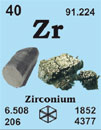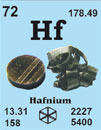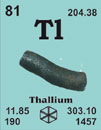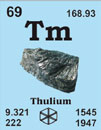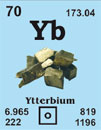Silizium 14Si28.086
1824 von J.J. Berzelius in Stockholm, Schweden, entdeckt.
[Lateinisch, silicis = Kiesel]
French: Silicium
German: Silizium
Italian: Silicio
Spanish: Silicio
Beschreibung: Man erhält schwarzes, amorphes Si durch Reduktion von SiO2 mit Kohlenstoff; hochreine Kristalle von Halbleiterqualität sind blaugrau metallisch. Massives Si reagiert nicht mit Sauerstoff, Wasser, Säuren (außer HF), aber löst sich in heißen Basen. Verwendung für Halbleiter, Legierungen und Polymere.
Silizium single crystal properties
| State: |
single crystal |
|---|
| Crystal structure: |
diamond |
|---|
| Production method: |
Czochralski, Floating zone |
|---|
| Standard size: |
Diameter 20-80mm
thickness 1mm |
|---|
| Orientation: |
(110) and (111) |
|---|
| Orientation accuracy: |
<2°, <1°, <0.4° or <0.1° |
|---|
| Polishing: |
as cut, one or two sides polished |
|---|
| Roughness of surface: |
<0.03µm |
|---|
| Purity: |
99.999% |
|---|
| Typical analysis (ppm): |
C 3
H < 1
O 9
N < 5
Cu 1.60
Fe 1.80
Ni < 1
Pb 0.30
Si 0.30
Ga, Hf and Ta are below the detection limit
|
|---|
Materials properties
| Density: |
2.33 g/cm3 |
|---|
| Melting point: |
1409.85 °C / 1683 °K |
|---|
| Boiling point: |
2354.85 °C / 2628 °K |
|---|
| Molar volume: |
12.06 cm3 |
|---|
| Thermal conductivity: |
148 [300 K] Wm-1K-1 |
|---|
| Coefficient of linear thermal expansion: |
4.2 x 10-6 K-1 |
|---|
| Electrical resistivity: |
0.001x 10-8 [273 K] Wm |
|---|
| Mass magnetic susceptibility: |
-1.8 x 10-9(s) kg-1m3 |
|---|
| Young's modulus: |
113 GPa |
|---|
| Rigidity modulus: |
39.7 GPa |
|---|
| Bulk modulus: |
n.a. GPa |
|---|
| Poisson's ratio: |
0.05-0.42 |
|---|
| Radii: |
Si4+ 26; Si4- 271 atomic 117; covalent 117; van de |
|---|
| Electronegativity: |
1.90 (Pauling); 1.74 (Allred); 4.77 eV (absolute) |
|---|
| Effective nuclear charge: |
4.15 (Slater); 4.29 (Clementi); 4.48 (Froese-Fischer) |
|---|
| Number of Isotopes (incl. nuclear isomers): |
11 |
|---|
| Issotope mass range: |
24 -> 34 |
|---|
| Crystal structure, (cell dimentions / pm), space group |
diamond |
|---|
| X-ray diffraction: mass absorption coefficients: |
CuKα 60.6 (µ/r) / cm2g-1
MoKα 6.44 (µ/r) / cm2g-1 |
|---|
| Neutron scattering length: |
0.41543 b/10-12 cm |
|---|
| Thermal neutron capture cross-section: |
0.171 sa / barns |
|---|
Biological data
| Biological role: |
Silicon is essential to some species and possibly to humans. |
|---|
| Toxicity |
|
|---|
| Toxic intake: |
|
|---|
| Lethal intake: |
|
|---|
| Hazards: |
The fibres of some silicates, such as asbestos-type minerals, are carcinogenic. |
|---|
| Level in humans |
|
|---|
| Blood: |
3.9 mg dm-3 |
|---|
| Bone: |
17 p.p.m. |
|---|
| Liver: |
12 - 120 p.p.m. |
|---|
| Muscle: |
100 - 200 p.p.m. |
|---|
| Daily dietary intake: |
18 - 1200 mg |
|---|
| Total mass of element in average [70 kg] person: |
c. 1 g |
|---|
Geological data
| Mineral | Formula | Density | Hardness | Crystal apperance |
|---|
| Cristobalite |
SiO2 |
2.33 |
n.a. |
tet., vitreous/white |
|---|
| Opal |
SiO2.nH2O |
2 |
5.5 - 6.5 |
amor., transp./col./white |
|---|
| Quartz |
a-SiO2 |
2.655 |
7 |
rhom., vit., colourless |
|---|
| Tridymite |
SiO2 |
2.26 |
7 |
mon., vit., colourless/white |
|---|
| Chief ore: |
quartz (most common mineral on earth); also talc, mica. |
|---|
| World production: |
|
|---|
| Main mining areas: |
talc in Austria, Italy, India, South Africa, Australia; mica in Cananda, USA, India, Brazil |
|---|
| Reserves: |
unlimited |
|---|
| Specimen: |
available as powder, pieces or lumps. Safe. |
|---|
| Abundances |
|
|---|
| Sun: |
4.47 x 107(relative to H = 1 x 1012) |
|---|
| Earth's crust: |
277 100 p.p.m. |
|---|
| Seawater: |
|
|---|
| Residence time: |
|
|---|
| Classification: |
recycled |
|---|
| Oxidation state: |
IV |
|---|

 English
English
 Deutsch
Deutsch








































